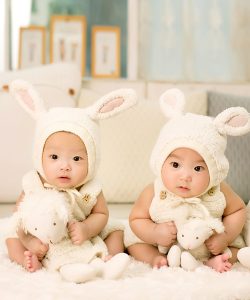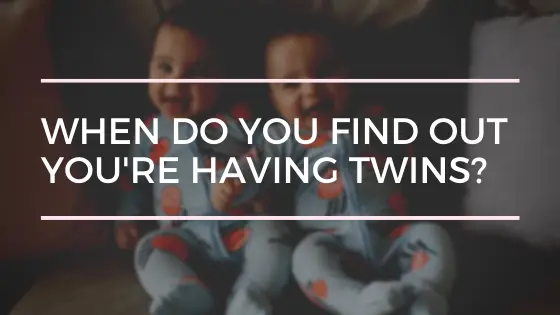Affiliate Disclosure – This post may contain affiliate links where we may receive compensation if you purchase products linked below. As an Amazon Associate, I can earn from qualifying purchases. This doesn’t cost you anything and helps keep our little blog running. Read our privacy policy for further information.
From 1980 to 2009, we’ve seen the birth rate of twins rise an outstanding 76 percent. According to a report in 2013, approximately 3 out of 100 babies were born as twins in the United States. The chances of having twins is more common now than ever before.
With the increased percentage of twins being born, you’re probably wondering to yourself how early can you find out that you’re having twins so you can begin planning your life accordingly? Good question. This article explores common symptoms of someone expecting twins, how early medical staff can work out whether you’re having twins and provide some fun facts about how twins form.
What are the Symptoms of Someone Expecting Twins?
While ultimately every pregnancy can vary, there is a strong belief that women that carry twins are more inclined to have greater symptoms compared to a singleton pregnancy that may be the tell tale sign that you’re carrying twins! 
We’ve created a list of some of the things which we see more of in people carrying twins. Like anything health related, book in to see a doctor for an ultrasound who will be able to help advise whether you’re having twins. Some of the symptoms of someone expecting twins include:
- More morning sickness – Carrying twins can be hard on your body especially when you’re carrying twins. Women who carry multiples are more inclined to experience more and harsher morning sickness than someone having a singleton pregnancy.
- Higher HcG levels in your urine test – While pregnancy tests are only made for identifying a singleton baby, it is thought that someone carrying twins may have higher HcG levels which in turn can result in you receiving an immediate positive result a few days before your period is due.
- Weight gain – It’s known that women carrying multiples are more likely to gain more weight than singleton mothers however this is more likely to occur towards the later part of the pregnancy so isn’t really a tell tale sign of a twin pregnancy in the early days.
- Severe fatigue – Similar to morning sickness, carrying twins can take its toll on your body and in turn this can result in higher levels of fatigue. If you’re starting to experience fatigue during your pregnancy, we recommend checking your work, stress levels, diet and other things which may be tiring you like children.
- Bigger and an earlier bump – Carrying two you’re more inclined to develop an earlier bump. Although it’s likely you’ll get a scan and a positive reading on twins before you begin to develop a bump, it’s something which you’ll
- Twin based risk factors – We know that certain people (family history of twins, IVF treatment, ages of 35+, above average height or weight and previous pregnancies) are all things which can increase your changes of having twins.
What Are the Different Types of Twins?
Before we go into detail around how early doctors can detect you’re having twins, it’s important to note the different types of twins you can have as certain types of twins can be detected earlier than others.
There are two different types of twins that exist which form differently. We know these as:
- Fraternal (dizygotic) that form when two eggs are fertilized by different sperm. These are the more common types of twins which generally run within the family. We know that you are more than twice as likely to have twins if your mother or sister is a twin. These are not identical twins and can result in boy girl combinations.
- Identical (monozygotic) which form as one fertilised egg is split into two different embryos. This type of twin is generally more rarer than fraternal twins where only 1 in every 250 pregnancies in Australia are identical twins. This is largely due to identical twins not running within families which is what we see increases frequency.
During the pregnancy, identical twins can form differently which can also have an impact on how early doctors can detect your twins. We know that there are three different types of identical twins. These are:
- Dichorionic diamniotic (DCDA) – The twins have their own placenta, inner membrane and outer membrane. DCDA occurs in about one-third of identical twins.
- Monochorionic diamniotic (MCDA) – The twins share the same placenta and chorion but will have their own amnion.
- Monochorionic monoamniotic (MCMA) – The twins share everything.
How Soon Can Doctors Tell You’re Having Twins?
 Now that you know the different types of twins out there, let’s talk about how soon doctors can pick up you’re having twins.
Now that you know the different types of twins out there, let’s talk about how soon doctors can pick up you’re having twins.
Doctors are able to pick up on DCDA (dichorionic-diamniotic) twins at around the 6 to 8 week mark. Remember this means they have their own inner & outer sacs and their own placenta. Thanks to the twins having their own sack, this is what helps doctors quickly identify whether you’re having twins and diagnose it early.
Generally other twins which do not have their own sack and share the placenta such as MCDA or MCMA twins are diagnosed a bit later when it’s easier to clearly see two seperate heart rates.
It’s important to catch twins early as around the 18 to 20 week mark, they can become more difficult to identify due to crowding.
When Can Doctors Tell the Gender of Twins?
It’s at around the 18-20 mark also that doctors are able to comfortably identify the babies sex. This is dependent on the babies being positioned in a way that allows them to get a good look at their genitals. Sometimes if your doctor is able to identify two placentas and one sex, you may have to wait until your twins are born to get the final answer to whether there are two boys or a boy girl combination.
Are my Twins Identical?
If your twins are DCDA like ours and had their own placenta, it can be confusing at such a young age to whether they are identical or not. Our boys looked really similar but would have moments when they looked different. We also wanted to know whether they were identical for when they became older and would share any genetic diseases where an identical sibling would share it.
For this reason, we invested in a DNA test which was around $150 and found that the boys were identical. We’re glad we spent the money as it sure makes conversations with people asking whether they’re identical or not much easier!
Affiliate Disclosure – This post may contain affiliate links where we may receive compensation if you purchase products linked below. As an Amazon Associate, I can earn from qualifying purchases. This doesn’t cost you anything and helps keep our little blog running. Read our privacy policy for further information.

My name’s Alex and I’m a husband, dad to beautiful identical twin boys, cyclist, photographer and connoisseur of great coffee!
Help I’m Having Twins has been created for me to share what I found useful as a new parent and dad to twins.


